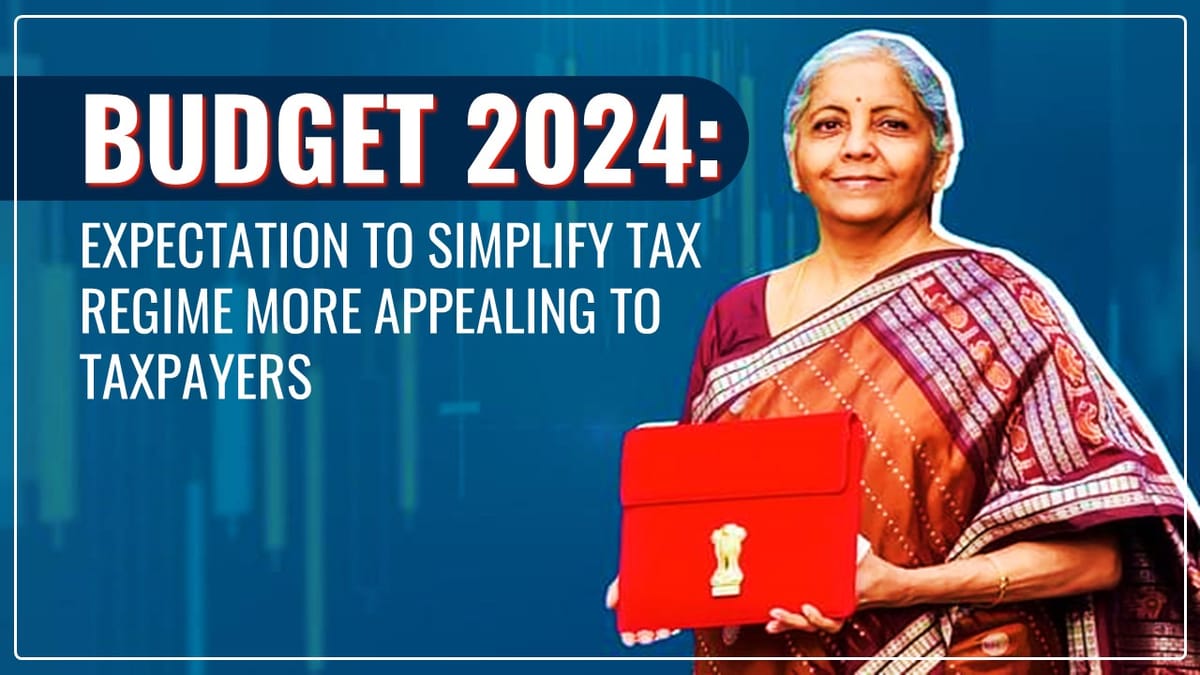To increase the appeal of the new tax regime, the government must strike a balance between simplification, incentivizing savings and investments, and increasing consumer spending, all while ensuring financial stability.
Reetu | Jan 30, 2024 |

Budget 2024: How FM Sitharaman may make simplified Tax Regime more appealing to Taxpayers
The new and simplified personal income tax regime was implemented in the 2020 Budget with the goal of streamlining tax compliance and providing significant relief to individual taxpayers. Individual taxpayers who forego certain deductions and exemptions will benefit from much lower income tax rates under the new tax regime.
The budget of 2023 boosted the personal income tax rebate threshold under the new tax regime from Rs.5 lakh to Rs.7 lakh, reduced the number of tax slabs from six to five, and raised the tax exemption ceiling to Rs.3 lakh. The highest surcharge rate was reduced from 37% to 25%, retirees and salaried individuals now have a standard deduction of Rs.50,000, and a family pension exemption of Rs.15,000 has been adopted.
As a result, taxpayers who choose the new tax regime will miss out on deductions such as House Rent Allowance, Leave Travel Allowance, deduction for interest on housing loans, deductions under Section 80C for investments in ELSS, term deposits, housing loan principle, and so on.
If a salaried taxpayer’s tax deductions/exemptions in the normal regime are Rs.2 lakh or higher for a total income of Rs.7 lakh, his tax payable will be equal to the tax under the simplified tax regime. To equate the tax number under the simplified tax system, a taxpayer with a total income of Rs.15 lakh should have around Rs.3.75 lakh in deductions.
Thus, taxpayers with larger levels of deductions will benefit more from the normal regime. However, taxpayers with high-income categories of Rs.5 crore and above will prefer the new tax regime due to the reduced surcharge rate.
While the new simplified regime has been designated as the default tax regime, the current tax regime remains in effect, and taxpayers can select the most appropriate one.
According to statistics presented up to FY 2021-22, many taxpayers did not prefer the simplified tax regime. As a result, in Budget 2023, the finance minister included a few concessions to make the regime more appealing.
It is predicted that at least 40% of taxpayers will choose the simplified tax regime in the financial year 2023-24.
The question arises as to whether the simplified tax regime affects taxpayers’ tax-saving investments. One feature of the regular regime was that it allowed for tax deductions on notified long-term investments.
To save on taxes, taxpayers invested in the Public Provident Fund (PPF), life insurance, and long-term fixed deposits.
As of August 2023, the number of subscribers to the National Pension System (NPS) and Atal Pension Yojana (APY) combined has increased to over 6.62 crore, with a total Assets Under Management (AUM) of Rs.10 lakh crore.
Over the last year, the number of contributing members to the Employees Provident Fund (EPF) has climbed to 7,62,25,799.
The number of EPF subscribers, as well as NPS subscribers, have increased or are expanding. However, future trends must be considered, as 40% of taxpayers are likely to transition to a simplified tax regime.
While the simplified tax regime allows taxpayers to invest their money in securities of their choice, one cannot deny that lower-income taxpayers’ investment decisions may be influenced because these taxpayers have a tendency to choose safer and more commonly used routes of investment such as PPF, NPS, and insurance premiums, which also provide a tax break.
Consumer spending is determined by a number of factors, including income level, savings, debt levels, future expectations, and so on. While the simplified tax system has a marginal benefit at lower income levels, it has a considerable benefit at higher income levels due to surcharge rates.
In such circumstances, taxpayers have more disposable income, which means more spending power, which helps to improve demand for goods and services and increases investment. That will help to boost economic growth.
The new simplified regime offers a simpler tax structure with less documentation. The government should consider implementing the adjustments gradually, giving taxpayers time to adjust and plan their taxes more effectively.
To increase the appeal of the new tax regime, the government must strike a balance between simplification, incentivizing savings and investments, and increasing consumer spending, all while ensuring financial stability. Continuous monitoring and modifications based on input will be critical to its success.
In case of any Doubt regarding Membership you can mail us at contact@studycafe.in
Join Studycafe's WhatsApp Group or Telegram Channel for Latest Updates on Government Job, Sarkari Naukri, Private Jobs, Income Tax, GST, Companies Act, Judgements and CA, CS, ICWA, and MUCH MORE!"